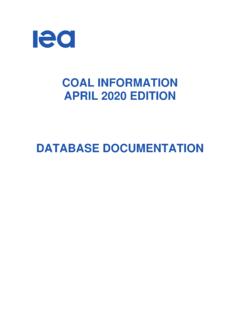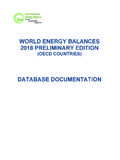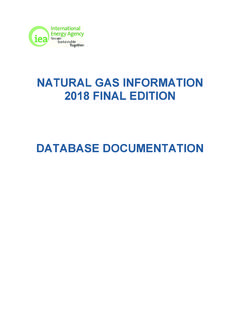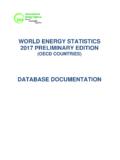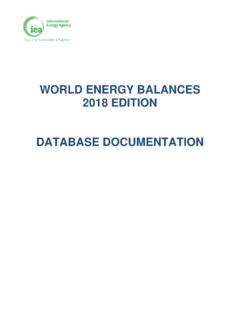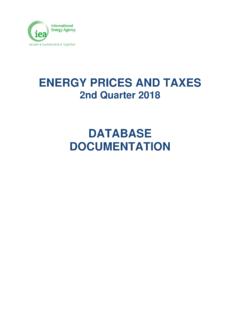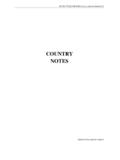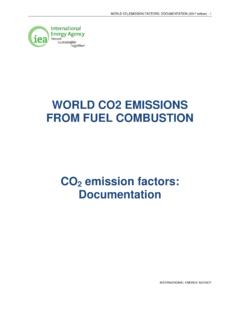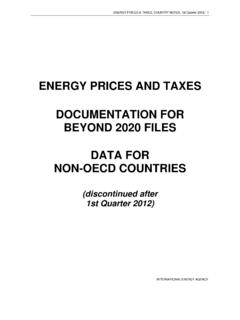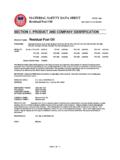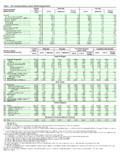Transcription of OIL INFORMATION 2018 EDITION DATABASE …
1 OIL INFORMATION 2018 EDITION DATABASE DOCUMENTATION 2 - OIL INFORMATION : DATABASE DOCUMENTATION (2018 EDITION ) INTERNATIONAL ENERGY AGENCY This document provides support INFORMATION for the IEA Oil INFORMATION DATABASE . This document can be found online at: Please address your inquiries to Please note that all IEA data are subject to the Terms and Conditions which can be found on the IEA s website at: OIL INFORMATION : DATABASE DOCUMENTATION (2018 EDITION ) - 3 INTERNATIONAL ENERGY AGENCY TABLE OF CONTENTS 1. CHANGES FROM LAST EDITION .. 4 2. DATABASE STRUCTURE .. 5 3. FLOW DEFINITIONS .. 7 4. PRODUCT DEFINITIONS .. 15 5. GEOGRAPHICAL COVERAGE .. 20 6. COUNTRY NOTES AND SOURCES .. 32 7. UNITS AND CONVERSIONS.
2 52 8. ABBREVIATIONS .. 56 4 - OIL INFORMATION : DATABASE DOCUMENTATION (2018 EDITION ) INTERNATIONAL ENERGY AGENCY 1. CHANGES FROM LAST EDITION Geographical coverage Mexico became the International Energy Agency s 30th Member country on 17 February 2018. Accordingly, starting with the 2018 EDITION , Mexico appears in the list of IEA Members and is included in the IEA zone aggre-gates for data starting in 1971 and for the entire time series. Brazil joined the IEA as an Association country in October 2017. Accordingly, Brazil is now included in the IEA and Accession/Association countries aggregate for data stating in 1971 and for the entire time series. OIL INFORMATION : DATABASE DOCUMENTATION (2018 EDITION ) - 5 INTERNATIONAL ENERGY AGENCY 2.
3 DATABASE STRUCTURE The Oil INFORMATION DATABASE contains six files of annual data : OECD files (Last updated July 2017) Countries: 35 countries and 5 regional aggregates (see section Geographical coverage) Years: 1960-2016 (unless otherwise specified see section Geographical coverage) OECD crude supply INFORMATION is provided in the form of supply and demand balances, presenting indige-nous production, imports, exports, stock changes and refinery intake. data are in kilo-tonnes. OECD product supply and consumption INFORMATION is provided in the form of supply and demand balances, presenting refinery gross output, recycled products, imports, exports, transfers, stock changes, international ma-rine bunkers and gross deliveries.
4 In addition, the table includes data on inland deliveries by sector: transformation, energy, transport, industry and other sectors, as well as the non-energy use. data are in kilotonnes. OECD Imports INFORMATION on OECD member countries imports from 104 origins for 22 products. This includes crude oil, NGLs, motor gasoline, gas/diesel oil, residual fuel oil and 15 other refined products. data are in kilotonnes. OECD Exports INFORMATION on OECD member countries exports to 95 destinations for 22 products. Included are: crude oil, NGLs, motor gasoline, gas/diesel oil, residual fuel oil and 15 other refined products.
5 data are in kilotonnes OECD Conversion factors This table includes the average conversion factors from tonnes to barrels, for the OECD countries and for 24 products. 6 - OIL INFORMATION : DATABASE DOCUMENTATION (2018 EDITION ) INTERNATIONAL ENERGY AGENCY WORLD file (Last updated July 2017) Countries: 140 countries and 24 regional aggregates (see section Geographical coverage) Years: 1971-2015 and 2016 preliminary production data World Supply INFORMATION is provided on crude oil and NGL production, refinery output, total trade and oil demand for the World, in kilotonnes and in kilobarrels per day. OIL INFORMATION : DATABASE DOCUMENTATION (2018 EDITION ) - 7 INTERNATIONAL ENERGY AGENCY 3.
6 FLOW DEFINITIONS OECD Crude Supply Flow Short name Definition Indigenous production INDPROD This includes all quantities of fuels extracted or produced within na-tional boundaries, including offshore production. Production includes only marketable production, and excludes volumes returned to for-mation. Such production concerns all crude oil, NGL, condensates and other hydrocarbons (including the receipts of additives). From other sources OSOURCES Refers to supplies of additives, biofuels and other hydrocarbons derived from other energies, such as coal, natural gas or renewables. Backflows BACKFLOW Backflows are finished or semi finished products which are returned from final consumers to refineries for processing, blending or sale.
7 They are usually by products of petrochemical manufacturing. Trans-fers from one refinery to another within the country are not included. Products transferred PTRANSF These are imported products which are reclassified as feedstocks for further processing in the refinery, without delivery to final consumers. Imports IMPORTS Comprise amounts having crossed the national territorial boundaries of the country whether or not customs clearance has taken place. Quantities of crude oil and oil products imported under processing agreements ( refining on account) are included. Quantities of oil in transit are excluded. Crude oil, NGL and natural gas are reported as com-ing from the country of origin; refinery feedstocks and oil products are reported as coming from the country of last consignment.
8 Exports EXPORTS Comprise amounts having crossed the national territorial boundaries of the country whether or not customs clearance has taken place. Quantities of crude oil and oil products exported under processing agreements ( refining on account) are included. Re-exports of oil imported for processing within bonded areas are shown as an export of product from the processing country to the final destination. Direct use DIRECUSE Crude oil, NGL and other hydrocarbons which are used directly with-out being processed in oil refineries are reported as direct use. This in-cludes, for example, crude oil burned for electricity generation. 8 - OIL INFORMATION : DATABASE DOCUMENTATION (2018 EDITION ) INTERNATIONAL ENERGY AGENCY OECD Crude Supply Flow Short name Definition Statistical differences STATDIFF National administrations sometimes obtain the data components of do-mestic availability from a variety of sources.
9 Owing to differences in concepts, coverage, timing and definitions, observed and calculated consumption are often not identical. This is reflected in statistical differences. Refinery intake (observed) REFINOBS Defined as the amount observed to have entered the refining process. Refinery losses REFLOSS Refers to the difference between Refinery intake (observed) and Refin-ery Gross Output. Closing stock level (national territory) CSNATTER Refers to closing stock levels, at the last day of the year, of stocks held on national territory (including government controlled stocks). OIL INFORMATION : DATABASE DOCUMENTATION (2018 EDITION ) - 9 INTERNATIONAL ENERGY AGENCY OECD Products Supply and Consumption Flow Short name Definition Refinery gross output REFGROUT This is the production of finished products at a refinery or blending plant.
10 This category excludes refinery losses, but includes refinery fuel. Recycled products RECYCLED These are finished products which pass a second time through the marketing network, after having been once delivered to final con-sumers ( used lubricants which are reprocessed). Imports IMPORTS Comprise amounts having crossed the national territorial boundaries of the country whether or not customs clearance has taken place. Quantities of crude oil and oil products imported under processing agreements ( refining on account) are included. Quantities of oil in transit are excluded. Crude oil, NGL and natural gas are reported as coming from the country of origin; refinery feedstocks and oil prod-ucts are reported as coming from the country of last consignment.
